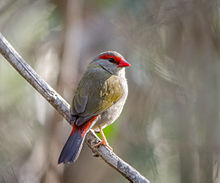Red-browed finch
| Red-browed finch | |
|---|---|
 |
|
| In Brisbane, Queensland, Australia | |
| Scientific classification | |
| Kingdom: | Animalia |
| Phylum: | Chordata |
| Class: | Aves |
| Order: | Passeriformes |
| Family: | Estrildidae |
| Genus: | Neochmia |
| Species: | N. temporalis |
| Binomial name | |
|
Neochmia temporalis (Latham, 1801) |
|
 |
|
| Approximate distribution in red | |
The red-browed finch (Neochmia temporalis) is an estrildid finch that inhabits the east coast of Australia. This species has also been introduced to French Polynesia. It is commonly found in temperate forest and dry savannah habitats. It may also be found in dry forest and mangrove habitats in tropical region.
The species is distinguished by the bright red stripe above the eye, and bright red rump. The rest of the body is grey, with olive wing coverts and collar. Juveniles do not have red brow marks, and lack olive colouration on the collar and wing coverts. The adults are 11–12 cm long.
The Red-browed finch was first described by the English ornithologist John Latham in 1801 under the binomial name Fringilla temporalis. It is one of four species in the genus Neochmia. Alternate names include red-browed firetail.
There are three noted subspecies: the nominate species N. temporalis temporalis, in most of the east coast, and inland New South Wales and Victoria; N. temporalis minor, which is distinguished by a white breast, in northern Queensland, and south-east of Australia, and N. temporalis loftyi in the south west corner of South Australia, although the latter is sometimes not listed as a subspecies, as the differences between it and the type species are relatively minor.
The finch is common in the south east of its range, from Brisbane to Melbourne. Subspecies N. t. minor is common between Cooktown and Townsville. The species is listed as being of least concern on the IUCN Red List. There are no key threatening processes for N. temporalis, although the Pest Animal Control CRC suggests that the introduced nutmeg mannikin (Lonchura punctulata), which currently threatens some native mannikins through increased competition, may be a minor threat to N. lateralis in northern Queensland.
...
Wikipedia

